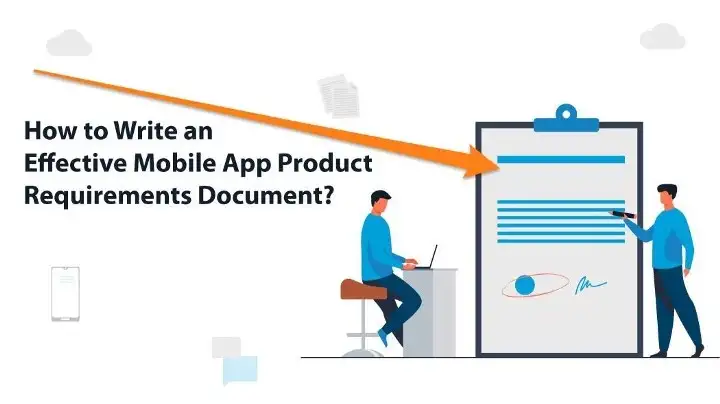What is a Product Requirements Document?
A Mobile app product requirements document gives the outline and a clear picture of the mobile app that is going to be made by the mobile app development team. An effective mobile app Product requirements document explains all the goals, requirements, and objectives of the business to the development team. So basically the PRD helps understand the intent behind the product to the development team. An effective and properly documented Product Requirements Document will clearly explain the idea of the app to the development team.
Let’s take an example, you want to develop a mobile application for your enterprise, you have given a short interpretation to the mobile app developers. However, the actually developed version of the app looks really different from what the company needs. The reason behind the difference between the actual app and the desired app arises because the developers didn’t get a clear picture of what the company expects. This is where the need for the Product Requirement Document arises, as it gives a clear picture of the requirements and functionalities that are needed in the app to the development team
Here are the steps for writing effective mobile app product requirements documents-
1. Explain the objective of the mobile app:- In this initial step of PRD you should outline the purpose of the app, how it will solve the user’s problem. This should be presented in such a way so that the reader can easily understand the purpose of the app.
- This step will basically answer these questions
- Who will benefit from this mobile app?
- The purpose behind the development of this mobile app?
- How and what problem it will solve?
- How this mobile app is different from others?
2. Categorize the objectives- Categorizing the objective of the app in various features will help you decide on the theme, Initial screen, home screen, user registration screen, etc. While breaking down the objectives in various features make sure these are outlined according to the purpose of the app.
3. Assign Goals- You need to identify and set the goals for evaluating the performance, usability, functionality, and reliability of the mobile app. These goals should be attainable, measurable, actionable, and relevant. The purpose of setting these goals is to provide solutions to the problems of the potential mobile app user.
4. Setting the priority features- Make sure to identify and communicate the Primary features to the development team through the PRD, which are really important and must-have for the mobile app. You can also mention the features which can be considered secondary. It will surely help your development team to focus on what is important.
5. Set the product release criteria- Defining the benchmarks for the various areas of the app before its release can be really beneficial for the success of the mobile app. Here are some of the areas where the minimum criteria should be assigned
- Functionality- Define the minimum functionality criteria in the product requirement document (PRD). This minimum functionality criterion should be achieved before releasing the app. Without fulfilling the mandatory functionalities your mobile app would be nothing.
- Performance- Determining the criteria for the performance of the mobile app will help your app achieve the basic performance capability to address the technical and non-technical problems. For example, how fast your mobile app needs to load should be outlined in the product requirement document (PRD).
- Reliability- A successful mobile app should be reliable enough to get recognition from the users. For example, making sure that mobile apps can recover from system failure.
- Usability- Setting the minimum usability criteria will make sure that your mobile app is easy to use and accessible by the user. Setting these criteria will help you present a useful app to the user that is the ultimate objective of any enterprise.
6. Define Timeline- Define the rough estimate of the release date of the mobile app in the Product Requirements Document. It is not an easy task to set the exact release date, you should consider workflow constraints such as resource, budget, etc. to set an ideal launch date for the mobile app.
7. Examining the effectiveness of the PRD – It is really important to examine the effectiveness of the product requirements document (PRD). You can ask your mobile app developers, stakeholders, investors, and other members to review and evaluate the mobile app product requirements document. After reviewing the PRD if they think it is good and properly outlining all the specifications, scope, requirements, and purposes of the mobile app, then it is considered effective. The objective of this step is to evaluate that the PRD is easily understandable by the team of developers.
8. Note down PRD on accessible and shareable tools – Use tools like PowerPoint and Google Docs to create your product requirements documents. Making the PRD on these documents allows you to easily access and share the document with team members. As your mobile app gets to build and updated, you also need to update your product requirements document. You need a tool that can help you update and edit your PRD easily.
Conclusion- A clear and productive Product Requirement Document can serve as the foundation for a successful mobile app. PRD helps to keep the record of the mobile app development process regularly. In order to get the desired results, you do not need to create your PRD entirely on other documents template as they are often illustrative. Create your own original PRD. Make sure to create an adaptive Product Requirements Document where you can add suggestions and other details to the PRD easily. Try to clarify and outline all the requirements, details, assumptions, and processes thoroughly in the Product Requirement Document.

